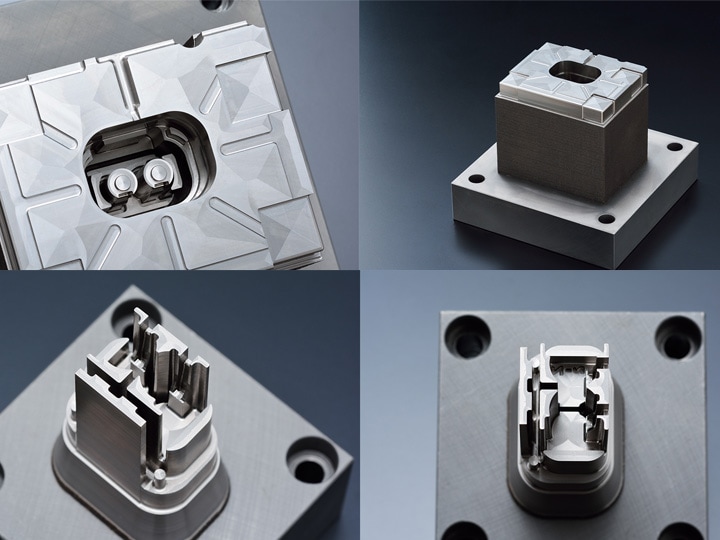 sales@incrementstech.com call us:+86 197 1029 9116
sales@incrementstech.com call us:+86 197 1029 9116
 sales@incrementstech.com call us:+86 197 1029 9116
sales@incrementstech.com call us:+86 197 1029 9116
Process:Selective Laser Melting (SLM)
How It Works
High energy laser beam is used to melt the metal powder on the two-dimensional section after slicing of the 3D model, and the solid parts are printed layer by layer from bottom to top
Technical Features
•Metal appearance, prototype and functional parts is built directly
•Function parts with high dimension precision and high surface precision can be directly manufactured
•Functional parts with complex geometry, high density and high mechanical properties can be built directly
•Raw material powder usually do not need special configuration
Industries Applied
•Processing the appearance, assembly,support,functional prototypes of standard metals in aviation and aerospace, bio-medicine and mold industry
•Single or small batch parts production, injection mold
Process:Electric Beam Melting(EBM)
How It Works
In vacuum environment, electron beam is used as heat source and metal powder is used as forming material. The metal parts are formed by scanning and melting the powder layer by layer
Technical Features
•High surface roughness
•High forming efficiency
•The ,micro-structure of built parts is more compact
•Metal parts with complex structure and excellent performance can be formed
Industries Applied
Active, refractory, brittle metal materials printing in
•Aviation and aerospace
•Automotive
•Mold industry
Process:Wire and Arc Additive Manufacturing(WAAM)
How It Works
Taking welding arc of tungsten inert gas welding (TIG), melting inert gas welding (MIG) or plasma welding power source (PA) as heat source, metal wire is melted layer by layer and accumulated to form the required parts
Technical Features
•High melting efficiency
•High utilization rate of wire material
•Overall manufacturing lead time short
•Low cost
•Less restrictions on parts size
•The internal quality of the formed parts is good
•Suitable for forming large size parts
Industries Applied
Small batch manufacturing, IN-SITU manufacturing,Hybrid manufacturing of large metal parts in
•Aviation and aerospace
•Automotive
•Ship
•Railway
•And other fields
Process:Laser Solid Forming(LSF)
How It Works
With laser beam as the heat source, the metal powder is sent into the molten pool formed by laser on the forming surface synchronously and precisely through an automatic powder feeding device. As the laser spot moves, the powder is fed into the pool to melt and then solidify, form the desired shape
Technical Features
•Significantly improve the mechanical and corrosion resistance of the raw material
•Fast manufacturing speed
•High material utilization rates
•Lower manufacturing cost compared to traditionally way of manufacturing
•Can form large size metal parts
Industries Applied
Single piece, small batch manufacturing, repairing and re-manufacturing in
•Aviation and aerospace
•Mining
•Electric power
•Mold industry
•And other fields
Process:Stereo lithogr aphy(SLA)
How It Works
Ultraviolet laser is usually used to scan liquid photosensitive polymers (such as propylene acid resin, epoxy resin, etc.) layer by layer to realize the curing of liquid materials, gradually stacking forming
Technical Features
•Suitable for photosensitive resin printing
•Complex structure printable
•High material utilization rate
•Large building area
•Low material cost
•Low built price
Industries Applied
•Light Industry
•Construction
•Culture and Design and decorations
•Education
•Toys and other industries
Process:Selective Laser Sintering(SLS)
How It Works
SLS 3D printing uses a high-power laser to sinter small particles of polymer powder into a solid structure based on a 3D model
Technical Features
•Wide range of forming materials include standard plastics
•Complex geometries, including interior features, undercuts, thin walls, and negative features are printable
•Parts produced have excellent mechanical characteristics,with strength resembling injection-molded parts
•Materials processable continues to increase, price advantage is obvious in small batch production
Industries Applied
•Aviation and Aerospace
•Households electronics
•Automotive
•Medical care
•Arts lights Decorations
Process:Fused Deposition Modeling(FDM)
How It Works
FDM builds parts layer by layer by selectively depositing melted material in a predetermined path, and uses thermoplastic polymers that come in the form of filaments
Technical Features
•The most widely used 3D printing technology
•High technical maturity
•Low cost
Industries Applied
•Automobile
•Furniture
•cultural and arts
•Advertising
•education etc
Process:Three-Dimension Printing(BJ/3DP)
How It Works
The powder coated layers are solidified using a liquid binder to create a 3D solid
Technical Features
•Forming speed is fast
•Price is relatively low
•Full color 3D printing with gradient color can be realized
•Large pieces can be printed (up to 4 meters can be printed at present)
Industries Applied
•Sand mold casting
•Architecture
•Arts and crafts, Animation
•Filming and television, etc


 Wechat number:WEIXINHAOMA
Wechat number:WEIXINHAOMA
Add wechat friends to learn more about products.
